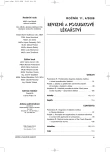Revision of statim examinations – what comes next?
Authors:
V. Blažej; A. Lichá
Authors‘ workplace:
ÚP VZP Ostrava
Published in:
Listy rev. Lék., 12, 2008, č. 4, s. 50-53
Overview
The authors deal with the definition of statim examinations, its inevitable change in relation to the implementation of new technology (POCT) and new knowledge in the intensive care. They state that practical revision of statim procedures in the broad context is not possible and it is not possible to lower extreme expenses on laboratory monitoring of seriously ill patients without changes of current reporting. Some practical solutions are suggested.
Key words:
statim examinations – POCT – revision
Sources
1. Koncepce oboru klinická biochemie s osnovou podle požadavku MZ ČR, 2000.
2. Englišová, M. Praktické připomínky k revizi laboratoří a klinické biochemie. Listy revizního lékařství, 2003, 2, s. 20–22.
3. Kovářová, S. Několik poznatků z revize nemocnic. Listy rev. Lék., 2002, 1–2, s. 21–23.
4. Cvachovcová, M., Vinšová, E. Revize JIP. Listy rev. Lék., 2003, 1, s. 8–9.
5. Havlíček, L., Šelle, J. JIP a ARO v revizích HZP. Listy rev. Lék., 2001, 3–4.
6. Dubovská, M. Revize komplementu. Listy rev. Lék., 2002, 1–2, s. 24–25.
7. Žmolíková, J. Aktuální problémy v revizní činnosti. Rev. posud. Lék., 2001, 1–2, s. 17–19.
8. Krinsley, J. S., Jones, R. L. Cost analysis of intensive glycemic control in critically adult patiens. Chest, 2006, 129, s. 644–650.
9. Frassica, J. J. Frequency of laboratory test utilization in th intensive care unit and its implifications for large – scale data collection efforts. J. Amer. Med. Ass., 2005, 12, 2, s. 229–233.
10. Innes, G., Grafstein, E., McGrogan, J. Do emergency physiancs know the cost of medical care? CJEM, 2000, 2, s. 95–102.
11. Calderon-Margalit, R. et al. An administrative intervention to improve the utilization of laboratory tests within a university hospital. Int. J. for Quality in Health care, 2005, 17, 3, s. 243–248.
12. Dickie, H. et al. Relationship between TISS and ICU cost. Intensive Care Medicine, 1998, 24, 10, s. 1009–1017.
13. Smellie, W. S. et al. Audit of emergency biochemistry service. J. Clin. Pathol., 1995, 48, 12, s. 1126–1129.
14. Křemen, J. et al. Léčba hyperglykémie u kriticky nemocných pacientů: srovnání standardního protokolu a počítačového algoritmu. Vnitř. Lék., 53, 12, s. 1269–1273.
15. Charvát, J. et al. Naše zkušenosti s kontinuálním podáváním inzulinu pomocí infuzního dávkovače na jednotce intenzivní metabolické péče (JIMP). Vnitř. Lék., 2007, 10, s. 1047–1053.
16. Giuliano, K. K., Grant, M. E. Blood analysis at the point of care: in application for use in critically ill patiens. AACN Clin. - Issues, 2002, 13, 2, s. 204–220.
17. McMulin, J. et al. Lowering of glukose in critical care : a randomized pilot trial. J. Crit. Care, 2007, 22, 2, s. 112–118.
18. Ramoska, E. A. Information sharing can reduce laboratory use by emergency physicians. Am. J. Emerg. Med., 1998, 16, 1, s. 34–36.
19. Hampers, L. C. The effect of price information on test-ordering behavior and patient outcomes in a pediatric emergency department. Pediatrics, 1999, 103, 2, s. 877–882.
20. Larsson, A. et al. Large differences in laboratory utilisation between hospitals in Sweden. Clin. Chem. Lab. Med., 2000, 38, 5, s. 383–389.
21. Ezzie, M. E., Aberegg, S. K., O’Brien, J. M. Laboratory testing in the intensive care unit. Crit. Care Clin., 2007, 23, 3, s. 435–465.
22. Miyakis, S. et al. Factors contributing to inappropriate ordering of tests in a academic medical department and the effect of an educational feedback strategy. Postgrad. Med. J., 2006, 82, 974, s. 823–829.
23. May, T. A. et al. Reducing unnecessary inpatient laboratory testing in a teaching hospital. Am. J. Clin. Pathol., 2006, 126, 2, s. 200–206.
24. Werner, M. Appropriate utilization and cost control of the hospital laboratory : panel testing and repeat orders. Clin. Chim. Acta, 1995, 16, 233, č. 1–2, s. 1–17.
Labels
Medical assessment Occupational medicineArticle was published in
Revision Medicine Journal

2008 Issue 4
Most read in this issue
- Revision of statim examinations – what comes next?
- Current status of gynaecology and obstetrics and review activities
